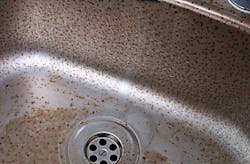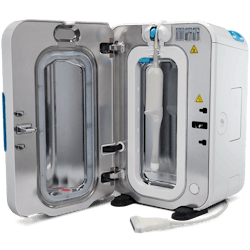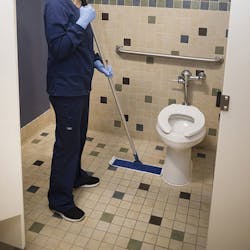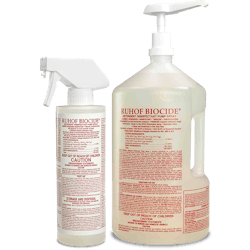The world of disinfectants for healthcare facilities – from those to disinfect surgical instruments and devices in Central Service/Sterile Processing & Distribution (CS/SPD) departments, to those used by environmental services (EVS) staff members to reduce microbes in rooms and on equipment – has changed in many ways throughout the COVID-19 pandemic.
CS/SPD and EVS teams, presented with a wide variety of products with some now labeled effective against the SARS-CoV-2 virus, have to ask more questions and seek more answers to ensure they are selecting the right solution for the job at hand.
Conversely, some elements of disinfection never change, including effectiveness, safety, compatibility with equipment and surfaces, and proper use in alignment with safety data sheets and instructions for use (IFU).
To clear up some questions, address misconceptions and help CS/SPD and EVS teams evaluate the variety of disinfectants available today, manufacturers and users of these products offer their insights on product selection and use.
Safety risks from improper disinfectant use
While chemical disinfectants can be used by staff members to safely reprocess instruments and maintain clean spaces, when misused these products can cause harm to users and those around them, including patients.
According to the Occupational Safety and Health Administration (OSHA), common unsafe work practices include mixing of cleaning products that contain bleach and ammonia; incorrect dilution of cleaning solutions, lack of proper PPE and inadequate ventilation.1
And it is not just EVS and CS/SPD staff who are at risk. A study published in JAMA Network Open found regular use of chemical disinfectants among female nurses to be a risk factor for the development of Chronic Obstructive Pulmonary Disease (COPD).
Among the 73,262 nurses in the study, 22.9% reported weekly use of disinfectants to clean surfaces and 19% to clean medical instruments. The study authors noted how the nurses were affected by high-level exposure to several disinfectants, such as glutaraldehyde, bleach, hydrogen peroxide, alcohol and quaternary ammonium compounds, “all exhibited significant associations with COPD incidence.”2
The CDC urges healthcare facilities to ensure staff members understand, “all potential health hazards and using all recommended protective measures, including barriers to prevent contact with body parts and respiratory protection. And for staff to follow ‘manufacturers’ instructions and product label directions for safe, effective use.”3
Hendee says many CS/SPD departments have transitioned away from disinfectants like glutaraldehyde because they require a protective hood system and staff exposure monitoring, stating:
“The patient safety factor is twofold. Ensuring the instrument is exposed to the disinfectant is the first, but the second is just as important. Thoroughly rinsing these stringent chemicals off the device is just as important and can cause adverse effects if they are not.”
Following the manufacturer’s IFU and labels also means leaving the disinfectant on the surface or equipment long enough to be effective. Inadequate dwell time presents its own safety risks, explains Chris Farrell, Enterprise Business Manager for Contec Professional. He states:
“COVID-19 has increased the demand for disinfectants, but it’s important that people pay careful attention to the dwell times for any product they use. If the chemical isn’t left on the surface long enough, the disinfectant’s efficacy is greatly diminished.”
Risks for equipment damage
Improper use of disinfectants can also damage medical equipment, instruments and care area surfaces. In a September 2021 memorandum, Alberta Health Services describes how improper cleaning and disinfection techniques can increase the risk for equipment damage and malfunctions, “leading to patient safety risks and increased costs.”4
“The COVID-19 pandemic has opened the eyes of patients and healthcare professionals even wider to the need for proper sanitation,” said Emily Lorcheim, Brand Manager for ClorDiSys Solutions. “Many healthcare associations are using increasing amounts of chemical methods of cleaning to not only combat viral transmission. However, these methods are often times not effective, or are damaging to surfaces. Many common chemical cleaners corrode surfaces, and even if not initially visible, there will be ever growing amounts of wear and pitting on these surfaces.
“As with any product used on reusable medical devices, ensuring those devices are not damaged/degraded by the product is essential,” added Hendee. “Disinfectant chemistries, especially sodium hypochlorite, can have adverse effects on metals and plastics.”
“Any amount of damage invites bacteria to enter even the slightest pitted or worn areas and begin biofilm formation,”, Lorcheim added, citing a study on the subject.5 “Electronics are another item that are extremely tricky to clean because of the complexity and risk of damaging both the surface and internal components by use of chemicals.”
One example of equipment that must be disinfected with care is ultrasound probes, explains Ken Shaw, President of the Americas, Nanosonics, stating:
“SPDs should ensure high level disinfectants are compatible with the ultrasound probes being reprocessed. Compatibility is essential to avoid probe damage. Damaged probes must be taken out of circulation, as they may have compromised image quality or could become reservoirs for pathogen growth, placing patient safety at risk. Probe manufacturers can void warranties if incompatible disinfectants are used so it’s essential to consult both the probe and disinfectant manufacturer’s IFU to ensure compatibility endorsement. If there are discrepancies, reach out to the manufacturers before implementing new products or processes.”
Todd Campbell, President of TBJ, says while his company has not come across any issues with its customers using disinfectants that are damaging to their stainless steel sinks, ultrasonic cleaners, tables and cabinets during the COVID-19 pandemic, there has always been an issue with customers using bleach as a disinfectant and not following IFUs for dilution.
How to select the right disinfectant
In its Hazard Communication for Disinfectants Used Against Viruses, the Centers for Disease Control and Prevention (CDC) notes how staff members must, “select the appropriate disinfectant based on the type of surface to be disinfected (e.g., hard surface, soft surface, electronics, fabric, etc.).”3
“The use of disinfectants in SPD must align with critical factors that play a role in the function and effectiveness of the products,” said Malinda Elammari, Clinical Education Specialist, Healthmark Industries. “Factors such as dwell time dictate how long the product must remain wet on a surface to be effective.”
“Other factors to consider are compatibility with the surface material, location and application of the disinfectant,” Elammari continued. “For example, when disinfecting the surfaces of a nursery, one should never use a phenolic-based disinfectant. An additional factor that SPD must take into account is the safety measures related to each specific product.”
“Comparing the materials compatibility stated in the device and the disinfectant manufacturer’s IFUs will be important to avoid unwanted damage or corrosion,” Hendee added. “If selecting a disinfectant wipe, consider how staff will meet the required contact time. Complying with a 5-minute wet dwell time will likely require an item to be wiped multiple times.”
During the COVID-19 pandemic, CS/SPD and EVS professionals have faced a new enemy in terms of disinfection - SARS-CoV-2 – requiring new weapons in their arsenals, or confirmation that existing disinfectant solutions are effective against the virus.
In March 2020, Ruhof Corporation announced that its Biocide Detergent Disinfectant Pump Spray proved effective against COVID-19, and in September 2021, that the product effectively kills all SARS-CoV-2 variants, including the Delta variant.
“As our country continues to battle SARS-CoV-2-2 we are seeing additional variants
of concern emerge, such as the Delta variant,” said Noreen Costelloe, Director of Marketing Ruhof Corporation. “We take our responsibility to support our customers very seriously and have followed up with the U.S. Environmental Protection Agency (EPA which regulates claims on disinfectant product labels.”
When asked for tips to evaluate the variety of products available today to disinfect instruments, Hendee states:
“My tip: Do your research ahead of time. Before purchasing a new device or the specific disinfectant recommended for it, use critical thinking. Ask yourself, is the facility already set up with everything needed to use it correctly? If the answer is yes, then that decision is more straightforward. If the answer is no, ask yourself, is there another device the facility is ready to use? The same applies to the disinfectant. If it requires specific tools or workflows to utilize properly, is the facility prepared for it. These details are important to know well ahead of the actual purchase.”
Non-chemical alternatives
While chemical disinfectants have long been used in the healthcare environment, new technologies have emerged that effectively disinfect without the risks associated with harsh chemicals.
Lorcheim explains how the use of ultraviolet light is shown to be gentler on surfaces and more effective (compared with chemical disinfectants). She points to a study on smartphone sanitation, which found “UV-C sanitization methods are potentially superior to disinfection with bleach, ethanol or quaternary ammonium solutions…Because of the risks of smartphone damage with exposure to liquid disinfectants.” This study also showed that UV-C was also the only sanitation mode that resulted in a complete kill of organisms as compared to chemical forms tested such as quaternary ammonium and bleach.6
“UV-C has the ability to provide kill to wherever the light is shining, without the use of chemicals and often times these are areas not reached by human personnel,” said Lorcheim. “It is a quick method of disinfection allowing for quick room turnover times. Plus, there is a reduction on excessive expenditures on consumables such as wipes. UV-C bulbs often have a lifetime of 16,000 hours, providing users a long return on investment.”
Automated HLD
Automated high-level disinfection (HLD) is another advancement that can help support both patient and SPD staff safety, while increasing efficiency in the SPD, explains Shaw. He states:
“Automation mitigates staff chemical exposure risk compared to manual bulk liquid high-level disinfection methods. Automated methods are also validated, ensuring expected microbiological performance outcomes are consistently achieved without dependence on human factors. This is essential to guarantee reproducible disinfection for every patient, consistently mitigating infection risk.”
“Automated processes also offer digitized traceability capabilities,” Shaw continued. “Digitization supports traceability standardization by minimizing manual administrative burden and associated risk of incomplete record keeping, when compared to paper-based methods.”
Cleaning one of the most contaminated spaces
While the CS/SPD department’s goal is to deliver clean and sterilized instruments into the hands of clinicians, the first step is for technicians in decontamination to remove bodily fluids, tissue, hair and other contaminants left over on instruments from prior patient use.
How do environmental services (EVS) professionals effectively clean and decontaminate CS/SPD departments experiencing a constant flow of dirty instruments arriving from clinical areas? It’s not easy.
Melissa G. Morgan, MSN, RN, CIC, CSPDT, FAPIC, Senior Systemwide Director for Infection Prevention & Sterile Processing for Moses H. Cone Health in North Carolina, recognized there were gaps in terminal cleaning for the health system’s six sterile processing departments. She sought out room disinfection technology that was both effective and safe.
“We want to ensure that one of the most contaminated spaces in the hospital is as clean as possible,” Morgan said.
Morgan and Cynthia Lee, Assistant Director for Moses H. Cone’s Sterile Processing Department, chose to implement a pilot program with the Tru-D SmartUVC technology. The robot uses UVC wavelengths at 254 nanometers to inactivate microorganisms, such as bacteria, viruses and protozoa. It offers an effective, environmentally friendly and chemical-free way to prevent microorganisms from replicating in an environment.
The Tru-D Sensor360 technology calculates the time needed to react to room variables, such as size, geometry, surface reflectivity and the amount and location of equipment in the room. The robot then effectively delivers the precise UVC dose needed during a single cycle from a single, central location in the room.
Tru-D and Moses H. Cone Health collaborated on a one-month trial to evaluate the system’s effectiveness in the CS/SPD. At the trial conclusion, Morgan presented the business case to the health system’s executive leadership, who approved the funds to purchase the device.
The Moses H. Cone Health EVS team has taken ownership of the UVC disinfection program, which Morgan believes has driven its success. Because the robot is activated by a remote control outside of a room, operators are free to complete other tasks, maximizing workflow and productivity.
“The staff loves having ownership of the Tru-D program, and they feel the organization values them for investing in this tool,” commented Morgan.
“Our team at Tru-D worked hand-in-hand with Moses Cone to ensure a successful trial,” said Bob Taylor, Senior Regional Sales Manager for Tru-D. “We look forward to a long-lasting partnership.”
Disinfectant Product Spotlights
References
1. Protecting Workers Who Use Cleaning Chemicals, OSHA, NIOSH, https://www.osha.gov/sites/default/files/publications/OSHA3512.pdf
2. Exposure to Disinfectants, Cleaning Products Linked to COPD Risk Among Female Nurses, AJMC, October 29, 2019, https://www.ajmc.com/view/assessing-potential-biomarkers-in-copd-to-reduce-corticosteroid-antibiotic-intake
3. Hazard Communication for Disinfectants Used Against Viruses, CDC, https://www.cdc.gov/niosh/topics/disinfectant/default.html
4. UPDATE: Equipment damage due to improper cleaning and disinfection, Alberta Health Services, September 10, 2021, https://www.albertahealthservices.ca/assets/healthinfo/ipc/hi-ipc-memo-clean-critical-device-risk.pdf
5. Otter JA, Vickery K, Walker JT. Surface-attached cells, biofilms and biocide susceptibility: implications for hospital cleaning and disinfection. J Hosp Infect 2015;89:16-27
6. Lieberman, Mia T et al. “Evaluation of 6 Methods for Aerobic Bacterial Sanitization of Smartphones.” Journal of the American Association for Laboratory Animal Science : JAALAS vol. 57,1 (2018): 24-29.
About the Author
Kara Nadeau
Senior Contributing Editor
Kara Nadeau is Sterile Processing Editor for Healthcare Purchasing News.






